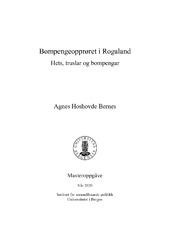| dc.contributor.author | Bernes, Agnes Hoshovde | |
| dc.date.accessioned | 2020-08-28T11:24:41Z | |
| dc.date.issued | 2020-08-28 | |
| dc.date.submitted | 2020-08-27T22:00:14Z | |
| dc.identifier.uri | https://hdl.handle.net/1956/23910 | |
| dc.description.abstract | Målet med denne oppgåva var å få økt kunnskap om bompengeopprøret som tok stad frå hausten 2018 til våren 2019 i Rogaland. Problemstillinga forsøkjer og gje eit svar på kva som gjorde at debattklimaet i bompengesaken vart så intenst og polariserande. I kor stor grad var hets og truslar ein del av debattklima, og korleis har det eventuelt påverka dei politikarane som var delaktive i debatten sin politiske deltaking. Eg ønskja og å sjå om det var noko kjønnsdimensjon når det kom til mengda hets og truslar lokalpolitikarane fekk under debatten. Oppgåva sin metode var eit kvalitativt casestudie av bompengeopprøret i Rogaland. Datagrunnlaget i oppgåva er samla inn ved bruk av eliteintervju som var semi-strukturelle. Datamaterialet besto av ni lokalpolitikarar i tillegg til ein journalist frå Stavanger Aftenblad. Respondentane er valt ut i frå strategiske omsyn med vekt på at dei var aktive deltakarar i debatten om bompengar. Denne oppgåva bidrar med å gje djupnekunnskap om korleis bompengedebatten i Rogaland var og korleis lokalpolitikarane opplevde debatten. Resultata frå analysen viser at hets og truslar i stor grad var tilstades i debatten om bompengar. Det er mykje som tyder på at det var eit kjønnsperspektiv i forhold til mengda hets og truslar politikarane fekk. Konsekvensane av hetsen og truslane for lokalpolitikarane sin politiske deltaking fann analysen at for fleire av respondentane så hadde det ført til at dei vart meir forsiktige når det kom til å uttale seg i politiske sakar og/eller at dei trakk seg litt tilbake frå politikken. Ut i frå svara frå respondentane kan ein og sjå at kvinnene opplevde fleire konsekvensar som følgje av hets og truslar enn det mennene gjorde. Når det kjem til kvifor bompengedebatten vart så oppheta som den vart så hadde respondentane ulike forklaringar. Det finnes ikkje ein tydeleg grunn til at debattklima vart som det vart, men at det var ein kombinasjon av mange forskjellige variablar. | en_US |
| dc.description.abstract | The aim of this master’s thesis was to gain increased knowledge about the toll fare uprising that took place from autumn 2018 to spring 2019 in Rogaland. The research question aims to provide an answer to what made the debate climate in the debate on toll fare so intense and polarizing. To what extent was harassment and threats part of the debate climate, and how has it possibly affected the politicians who were involved. I also wanted to see if there was any gender dimension when it came to the amount of harassment and threats the politicians received during the debate. The method in this thesis was a qualitative case study of the toll fare uprising in Rogaland. The data base in the thesis was collected using elite interviews that were semi-structural. The data material consisted of nine politicians in addition to a journalist from Stavanger Aftenblad. The respondents were selected on the basis of strategic considerations, with emphasis on the fact that they were active participants in the debate on tolls fare. This master’s thesis helps to provide in-depth knowledge of how the toll fare debate in Rogaland was, and how the politicians experienced the debate. The results from the analysis show in that harassment and threats were largely present in the debate. There are many indications that there was a gender dimension in relation to the amount of harassment and threats the politicians received. The analysis found that the consequences of the harassment and threats on the politicians' political participation was that for several of the respondents it had led to them being more careful when it came to speaking out in political matters and / or that they somewhat removed them self from politics. Based on the responses from the respondents, one can see that the women experienced more consequences as a result of harassment and threats than the men did. When it comes to why the toll fare debate was as heated as it was, the respondents had different explanations. There is no clear reason why the debate climate was as it was, but that it was a combination of many different variables. | en_US |
| dc.language.iso | nno | |
| dc.publisher | The University of Bergen | |
| dc.rights | Copyright the Author. All rights reserved | |
| dc.subject | bompenger | |
| dc.subject | debattklima | |
| dc.subject | truslar | |
| dc.subject | hets | |
| dc.subject | lokalpolitkere | |
| dc.title | Bompengeopprøret i Rogaland. Hets, truslar og bompengar | |
| dc.title.alternative | The toll fare uprising in Rogaland | |
| dc.type | Master thesis | en_US |
| dc.date.updated | 2020-08-27T22:00:14Z | |
| dc.rights.holder | Copyright the Author. All rights reserved | en_US |
| dc.description.degree | Masteroppgåve | |
| dc.description.localcode | SAMPOL350 | |
| dc.description.localcode | MASV-SAPO | |
| dc.subject.nus | 731114 | |
| fs.subjectcode | SAMPOL350 | |
| fs.unitcode | 15-13-0 | |
| dc.date.embargoenddate | 2021-08-06 | |
